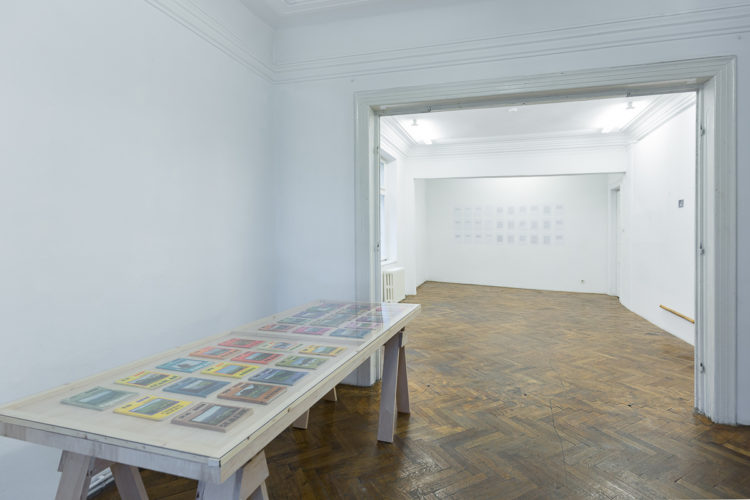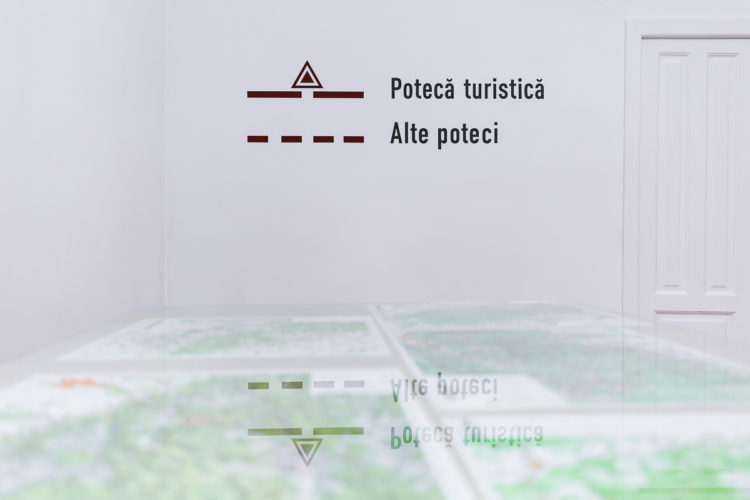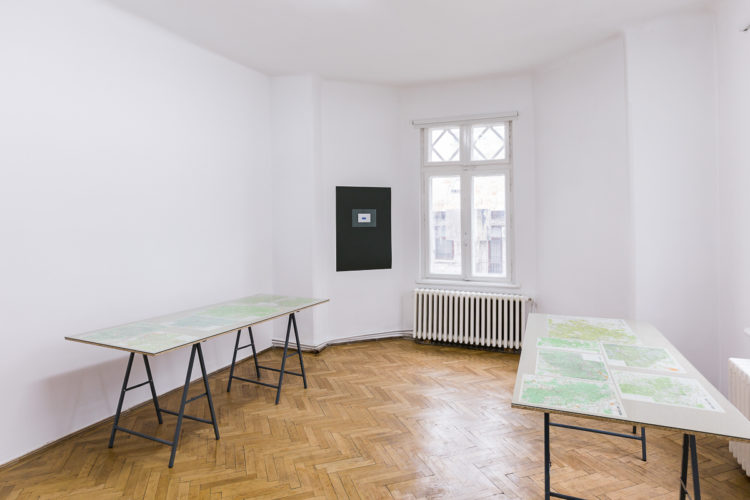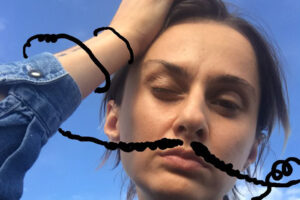February 14, 2018
By Valentina Iancu
What Do The Mountains Hide?
Late last year, Ivan Gallery opened the exhibition Do the mountains know?, a retrospective of the artists Ion Râmnic and István Mihály, active in Transylvania. The group was discovered by Mircea Nicolae, the curator of the exhibition, during a research residency in Târgu Mureş. Mircea Nicolae has contextualized in the artists’ bio and body of work a series of queer performative actions (pre-queer, to be exact) that took place in the Carpathian mountains, on various touristic routes. I talked to Mircea Nicolae about the project Do the mountains know?, which fills a noteworthy gap in Romania’s art history in the second half of the 20th century.

“Do the mountains know?” exhibition view. ©Ivan Gallery
For those who have not seen the retrospective you curated at Ivan Gallery, what makes this project so urgent today? How is it new?
I think it’s about a sync with the times we live in. What I am trying to say is that both the landscape of Romanian contemporary art as well as the history of the Romanian public space in the 70s and 80s are suddenly very relevant today. I’m thinking of both the innovative forms of artistic labor during those years, reclaimed by today’s mainstream, often in very fictionalized forms, as well as initiatives such as The Family Coalition, who purposefully want to limit human rights and shrink, by all means possible, today’s public space.
The novelty is “the discovery” of these unknown artists from Târgu Mureș who fill a gap in the local art historiography, which is missing entire categories of social actors. In fact, they were extremely lucid about the times they lived in and have often led extremely useful lives for their communities while also being productive on a cultural level.
In the exhibition’s first room you appealed to specialists in order to study the duo’s art. Can you briefly tell us about their history? Do you think they will allow themselves to be studied?
We’re talking about two artists born in 1942. Ion Râmnic is born in Reghin and Istvan Mihály in Miercurea Ciuc. They meet in 1960 at the Art University in Cluj. From then on they started working together, at first as students and then as independent artists.
In 1965 they initiate the project Do the mountains know?, a series of performative works that question new art’s relationship with the public, nature, but also the social body with all its limitations. The actions occur between the 70s and the 80s and continue, with a few interruptions, to present day. The place chosen by the duo for their artistic work was the natural landscape of the Carpathian mountains, using official mountain guides.
Along with their independent artist labor, the two earn their bread and butter by doing decorative mural art for the architectural projects of that period – meaning factories, schools and other local institutions.
I am inclined to think that in the future, these artists will more likely offer their art to be studied, keeping their private lives for themselves.

“Do the mountains know?” exhibition view. ©Ivan Gallery
After concluding your research, what is your overall understanding on their art, how do you define it?
I think my curatorial project is more like an accidental encounter with an artistic universe I did not know. I spent two weeks in the B5 Studio archive, which helped me find a few clues about the existence of this body of works. My idea was to ask the artists for permission to bring some of it to the surface as soon as possible.
If I were to try to properly answer your question, I would say that beyond the novelty of these previously unknown works, but also beyond the novelty of the sudden discovery of authors in the cultural archive, the duo’s work has a very typical feel for what was going on in the 60s and 70s in Romanian art.
In short, as Ileana Pintilie points out, UAP artists led double lives. In the public space they would execute the state’s orders on preset themes. In the private space, meaning their studios and personal lives, most of them would work on experimental art. The focus on action, detrimental to painting or sculpting, considered traditional, is the defining mark of the 60s, 70s, even 80s.
Beyond the trends of those times, in trying to define the particularity of the duo’s art, I would say that from the very beginning they made use of the ephemeral support of actions in landscape in order to question their own theoretical preoccupations with the limits of new art while also investigating issues related to sexuality and personal freedom.
Then, historian Hans Belting notes at some point that there is a fundamental difference between Western European artists and those from the East, especially before 1989. According to him, it all boils down to the fundamental belief in the power of art, which disappeared a long time ago in the West.
I think this is a good starting point for understanding Ion Râmnic and Istvan Mihaly’s art. I am precisely thinking that this series of gestures occurred out of the need to communicate with oneself and others. But also out of the need to position oneself assertively and without compromise when facing oneself as well as the social and historical context.
How did they avoid the obligation of producing official art?
Seeing as they did produce decorative art, it’s difficult to say that they completely escaped. Next to explicit propaganda art, which was linked to the personality cult of the political leader, especially after the 70s, decorative art was strongly encouraged by the regime precisely for its apparent neutrality. It’s clear that this neutrality can also be a form of abandonment. On the other hand, given the double lives of artists in those times, split, as it were, between official art and studio art, it is important to see how the two are in balance. In the case of the aforementioned artists, it is an escape to the neutral field of decorative art in public and working free from official art in private.
How far did their homoeroticism go? Did they live together, hidden until 2001?
The notion of homoeroticism is a bit inadequate in this context. Their project contains obvious clues that this is a couple of men who’ve lived and worked together their entire lives. On the their hand, the eroticism in their work is rather poetic. To be more clear, it is not about eroticism, it is about love. In fact, this is one of the things that drew me to their work, where one can see bits of their private lives as well. The fact that two people fight in order to live with dignity their own choices and emotional lives. I wouldn’t say they stayed hidden because both were present in the public space most of the time, since the 70s, via their professional lives as decorative artists.
On the other hand, yes, it’s clear that they protected their intimacy from those around them. And rightly so, seeing as Târgu Mureș is marked by two nationalisms, Hungarian and Romanian, both of which have very little tolerance for sexual minorities, Roma people or the poor.
And so, by staying in a hyper-conservative city, the two chose to live their lives in peace, enjoying their professions, their artistic work and their intimacy.
Another important aspect is that this distance imposed by the very society in which they lived offered them the chance for a more or less pleasant life, but also the chance to more accurately observe what is going on around them.
It is infamously known that in Romania, between 1938 and 2001, the practice of homosexuality was punishable by law. Art critic Petru Comarnescu often brought lists of gay cultural actors to the Communist Security. Although Boia does not speak of this in the document selection for his volume dedicated to notes by Comarnescu [1], the “Anton file” is an important testament to life in gay communities during that period. Ion Râmnic and István Mihály show up on a secondary list (only) as a suspected of homosexuality. Do you know of their experiences as such?
[The state has yet to declassify the archives for the moral militia!]
Since the start of this project, I’ve tried to be discreet and disassociate the artists Ion Râmnic and Istvan Mihály from their corresponding historical characters. What I mean is that I did not ask more questions than were needed to and I did not look for more information beyond what was shared with me.
The reason is precisely the legislative issue you mentioned.
I considered that my mission, as curator, is to put the works in context as best I can. And to protect the artists from those who want to retroactively punish them for their entire lives. During the opening in Târgu Mureș for example, many have asked where the artists were. Clearly they were asking because they wanted to pin their responsibility for their works.
I am surprised to learn of all the things you mentioned to me, but only just a little, to be honest. I have no doubt that things are as they are. On the other hand, with the two still alive, still living in an hostile environment, I did not try to learn of their personal experiences beyond what was presented to me in the works.
With the content being as explicit as it was, no further explanations were needed. I think they themselves can own up to this kind of responsibility. Or they can refuse to, depending on what they consider is best for their own lives.
I personally believe their artistic gesture to be somewhat edgy and that documentary proof can only add a little more to the understanding of their production work. But my impression is that their art projects are stronger statements than simply being a suspect by a repressive state.
With all the data that has been reveled, I will step aside and let art historians carry on the mission of placing the duo’s art in a legal context, with hope that these interpretations will accentuate the importance of their artistic work within a punitive historical context that can be proved, as we have it, with documentation.

“Do the mountains know?” exhibition view. ©Ivan Gallery
I perfectly understand their desire to remain anonymous and outside the system and I think it is admirable that they allowed their story to carry on. If later they would change their minds and decide to exhibit their works, do you think they would be understood?
In a way, we’re already beyond that point due to this exhibition’s existence. So we can already say that, at a professional level, as contemporary artists, the two have been reclaimed by the collective memory, albeit temporarily. Speaking of today’s contemporary art system and its commercial side, the artists appear to have little interest, in the sense that, at 76 years of age, they are not reckless enough to put hope in market success.
Their interest remains linked to the idea of pursuing an internal need for saying something about the world we inhabit. As luck would have it, as a curator, I also received their approval to showcse their works after all this time.
For me, another decisive aspect was the fact that 2017 was profoundly marked by the discussions around the Family Coalition, a context in which the exhibition presents other ways to look at intimate life beyond this violent and so very banal standard according to which the body does not belong to the individual, but to the community who can decide what to do with it in private.
So I’d say the artist did change their minds, the time finally came.
Then, the chances of them being understood are big, be it by friends or enemies. The duo’s art is extremely direct, even if it makes use of poetry as a state, of literary text as a medium or of aesthetic for as object.
The chances of being accepted only as artists by a majority very much depends on the soul components of said majority.
But I have a feeling that the artists have long given up searching for approval from those unwilling to offer it. And that in this context it is more important to turn a private archive into public goods, but also the fact that this archive, presented in fragments in the exhibition, is extremely useful, thus healing various personal and collective wounds.
I think there are many that feel redeemed by the two artists’ story which is so visible within the art show.
I also think many will enjoy this gift beyond their immediate understanding, be it narrow or extended, depending on the viewer.
Do you think art can still play a mediating role in opening the majority to the minority? The Family Coalition’s action is fueled by an extreme gesture of mobilization justified by a very high degree of conservatism and I am wondering if hate is the sole motivation on a personal level. There is a great amount of time to invest in collecting 3 million pledges for a subject that is not a priority in heterosexuals’ lives. The gay family is a taboo (or blamed) subject in Romania.
My impression is that the role of art was never to mediate. It is not about a more friendly presence in the social space which also has the time and availability to take care of others. I rather think that art keeps consciousness alive for those who practice it and those who admire it. After many years in which I naively believed we were dealing with a majority, I now know that the type of people who live around contemporary art is extremely small. But this does not deny the possibility of others, from other social positions, to gain access.
But access is conditioned by both culture as well as the necessity to invest constant intellectual effort.
Still, I believe that the art field is an area in which solidarity with other social classes can be affirmed more easily. Here, entire discussions on society, which can indeed be useful to the majority as well, are possible. But there is also need for availability. I no longer believe it is art’s mission to change people. I thin that citizens also have the obligation to broaden their horizons. If they don’t they remain the same, and that is up to them, their responsibility. Yet it’s obvious that their limitations echo in our society.
I am talking about indifferent people and their access to culture, not about those who cannot afford it, no one can blame them of anything. And by strictly referring to those who are indifferent, who indeed form a majority as seen in the large number of pledges, I hold them responsible for their ignorance as well as their violence.
Although a majority hides behind numbers in order to evade responsibility for acts they would dare not commit against their own community, all those present there, in those lists, in the public space, are responsible.
In this context, The Family Coalition and the discussion on the gay family is actually a pretense in order to see how far can violence go without any consequences. It is only a antisocial exercise of setting limits for the other, pretty typical for a majority with sociopathic tendencies.
It doesn’t even matter that the country has entirely different problems. The 40% poverty rate, the economic deficit, nor the hate climate of the country matter. Because, behold, a majority finally has control. And since they firmly believe there is no one else in the world besides them, they can afford to victimize other so they can feel better about themselves.
The gesture of switching names is noble, their reality is performative and with very important political meaning. What is it about?
In 1990, after the inter-ethnic conflict in Târgu Mureș, Ion Râmnic legally changed his name to Istvan Mihály and his partner became Ion Râmnic. Of course, it is a polemic gesture and an attempt to distance themselves from the violence in the public space of those days.
Like in other works, the name change meant for the two artists highlighting the alternatives when faced with a violent present which, quite often, forgets about the idea of solidarity, hiding it behind imagined collective fears, most of the time completely false, whose consequences can always be avoided, minimizing their destructive effect.
A political marriage. Can we talk about a queer art, or more precisely pre-queer?
My impression is yes. It is a pre-queer art in the sense that this term is more recent than the artists we’re referring to. Râmnic and Mihály have been working together since the 60s and the term queer comes into its own as a distinct notion, as we know it today, sometime in the mid 80s.
On the other hand, in hindsight, it’s clear that the duo’s projects are directly linked to the legal, symbolic and private domination of hetero-normativity. What I am interested in from this discussion is the fact that Râmnic and Mihály interpret the difference as a basis where a large social solidarity must be built.
I think that this civic aspect, which escapes the narrow frame of gender politics, being linked to the idea of equal rights in the most general sense, is an extremely relevant attitude in the current context.
The two artists seem to be saying, along with many others, that it is these differences that tie us together as a human community. And the work to label and separate social actors based on these differences is not only violent, but also useless and impossible to win long term.
[1] Lucian Boia (ed.), The secret files of Anton Petru Comarnescu in the Security’s archives.
Do the mountains know?, an exhibition curated by Mircea Nicolae, took place at Ivan Gallery between 15.12.2017 – 31.01.2018.
POSTED BY
Valentina Iancu
Valentina Iancu (b. 1985) is a writer with studies in art history and image theory. Her practice is hybrid, research-based, divided between editorial, educational, curatorial or management activities ...



